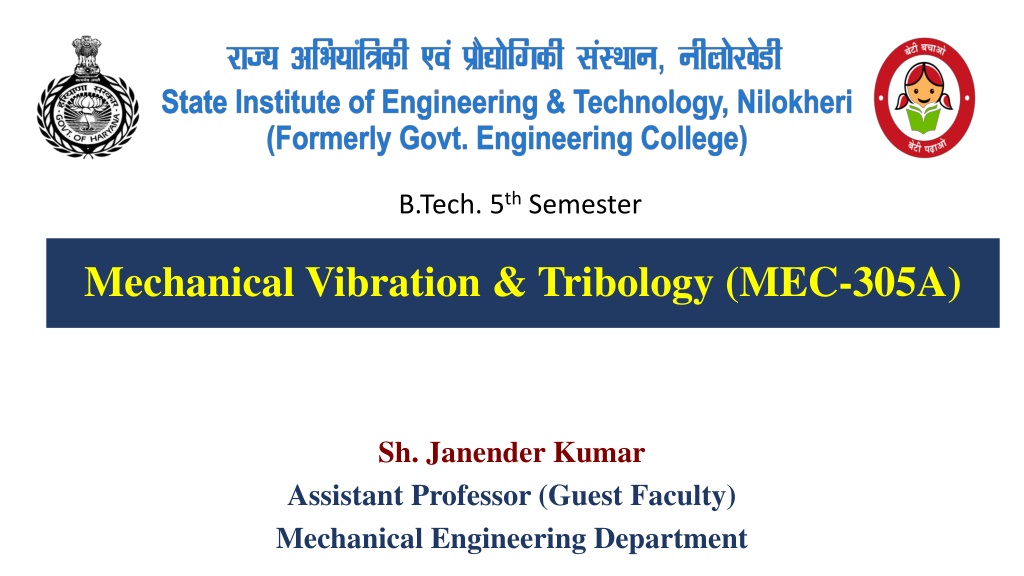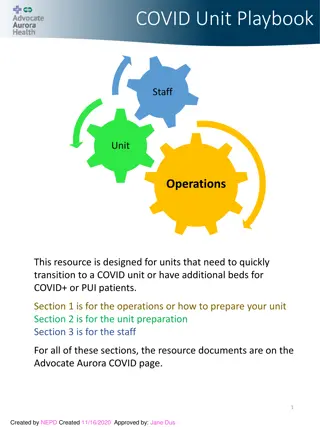Understanding Tribology: Friction, Wear, and Lubrication in Mechanical Engineering
Mechanical Vibration & Tribology delves into the science of interacting surfaces in motion, focusing on friction, wear, and lubrication. Tribology aims at controlling friction, preventing wear, and optimizing lubrication to enhance equipment reliability and reduce breakdowns.
Download Presentation

Please find below an Image/Link to download the presentation.
The content on the website is provided AS IS for your information and personal use only. It may not be sold, licensed, or shared on other websites without obtaining consent from the author. Download presentation by click this link. If you encounter any issues during the download, it is possible that the publisher has removed the file from their server.
E N D
Presentation Transcript
B.Tech. 5th Semester Mechanical Vibration & Tribology (MEC-305A) Sh. Janender Kumar Assistant Professor (Guest Faculty) Mechanical Engineering Department
Tribology: Introduction Tribology is the science dealing with interacting surfaces which are in relative motion with respect to each other. It derived from Greek word Tribos which means rubbing.
Elements of Tribology -Friction -Wear -Lubrication
Friction: Friction: Friction:- when there is relative motion between the surfaces of two bodies in contact, then it has been observed that a resistance to motion is set up due to the nature of the surfaces in contact, this resistance is termed as friction or frictional resistance. Importance of friction:- somewhere, we want more friction for our convenience or sometime we reduce friction for our need also. e.g. 1.The provision of sufficiently large friction as in walking, gripping objects and driving cars. 2. The reduction of friction in case of machinery because more energy will consume, wear can take place and parts can broken.
Wear: Wear is the removal of material from one or both of two solid surfaces in relative motion is termed as wear. Wear can be either desirable or undesirable. 1.Desirable cases of wear include machining, polishing, shearing and writing with a pencil. 2. Undesirable cases include almost all machine applications such as bearing, gears, cams and seals.
Lubrication Lubrication is the action of introduction of a lubricant between two surfaces having motion. - Basically, the function of a lubricant is to minimise friction and wear.
Tribology basically deals with the technology of: -Control of friction -Prevention of surfaces from wear, having relative motion under load -Lubrication
Tribology -is the art of providing operational analysis to the problems of great economic significance, namely: maintenance, reliability and wear of equipment from household items to space craft. With the consideration of tribological aspect, we want to reduce breakdowns, wear of machine components and increase reliability.
Tribology in industry There is no mechanism, m/c and equipment which is not affected by tribological factors. This shows the importance of tribological study. - 70% failure in mechanical components are due to tribological aspects Following are the considerations: Energy losses -Tribology is vital to modern machinery involving sliding and rolling surfaces. -Brakes, nuts, bolts, driving wheels on automobile use friction in a productive manners.
-Wear is also used in a productive manners in many cases such as writing with a pencil, machining, shaving. Unproductive wear & friction take place in engines, gears, cam, bearing and seals. If unproductive, wear and friction occurred then the loss of energy and also material which directly make the loss of money.
-When we talk about machineries, if friction and wear are more than the acceptance level then plant efficiency will decrease, more breakdowns , poor performance and loss of capital. Wear Wear can also cause accidents. It will create huge loss to human life also. Control Some amount of minor design defects are corrected at manufacturing stage and some manufacturing defects are corrected at installation and commissioning stage by use of tribology.
Operation and maintenance Maintenance personnel have to use tribology in order to take necessary actions on equipments to reduce chances of wear, friction and damages so that equipments can work for long time and trouble free.
Tribological system Tribo-system consists of surfaces of two components that are in moving contact with each other and their- near by surrounding also. The materials of those two components and their finishing along with their surroundings, lubricants and operating conditions determine the type and extent of wear. See figure below: 1.Component no. 1 2.Component no. 2 3.Lubricant[ grease, oil, water etc.] 4.Surroundings 5.Load applied 6.Motion
Lubrication:- Dry friction:- -is resulted from the sliding of the two rubbing surfaces without any film of lubricant in between them. Boundary friction:- -is resulted when the two sliding surfaces are separated by a thin film of lubricant oil.
Lubrication:- is the most important component of tribology as it takes care of the two evils; Friction & Wear. Lubrication is the use of a substance to provide smoothness to the movement of surfaces of m/c elements which move relative to each other. The substance used to achieve this purpose is termed as lubricant.
Fundamentally, function of lubrication is to reduce the friction and wear. In addition to these, they perform several other important functions:- 1.They act as a coolant. 2.Protect surfaces against corrosion. 3.Flush away contaminants and provide damping effects. 4. Reduce noise and act as a sealant.























